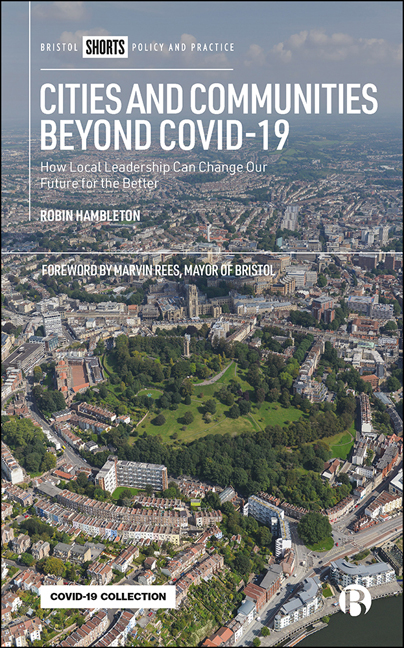Book contents
- Frontmatter
- Contents
- Lists of Figures, Tables and ‘Innovation Cameos’
- About the Author
- Acknowledgements
- Foreword
- One No Going Back
- Two The COVID-19 Pandemic
- Three The Central Challenge: Improving Governance
- Four The New Civic Leadership
- Five The Bristol One City Approach
- Six Enhancing the International Conversation
- Seven Lesson Drawing for the Future
- Index
Two - The COVID-19 Pandemic
Published online by Cambridge University Press: 12 March 2021
- Frontmatter
- Contents
- Lists of Figures, Tables and ‘Innovation Cameos’
- About the Author
- Acknowledgements
- Foreword
- One No Going Back
- Two The COVID-19 Pandemic
- Three The Central Challenge: Improving Governance
- Four The New Civic Leadership
- Five The Bristol One City Approach
- Six Enhancing the International Conversation
- Seven Lesson Drawing for the Future
- Index
Summary
Introduction
This chapter provides a concise overview of the COVID-19 pandemic. By drawing on the extensive news output and published scientific reports, the aim is to explain what a coronavirus is, to identify the origins of the COVID-19 pandemic, and to provide an international overview of the way the disease spread so rapidly across the world. Attention then turns to consider the performance of UK central government. A final section considers the main features of the COVID-19 pandemic, and identifies some of the key policy issues that the disease now presents to societies across the world.
What is a coronavirus?
First discovered in domesticated chickens in the 1930s, coronaviruses are a group of viruses that cause disease in animals. Seven, including COVID-19, have made the jump from animals to humans. When first discovered in humans in the 1960s, the viruses were found to cause relatively mild, coldlike symptoms. However, more lethal versions have emerged in more recent years.
Severe acute respiratory syndrome (SARS), the first deadly epidemic caused by a coronavirus, reached 29 countries in 2002 and 2003. Infecting around 8,000 people, and killing just over 800, it was contained by good public policy coupled with an element of good fortune. Traditional public health measures, such as testing, isolating patients and screening people at airports and elsewhere, proved to be effective. However, SARS was easier to control than COVID-19, because it was less transmissible; those infected were probably not contagious until they were very ill.
First reported in Saudi Arabia, another lethal coronavirus is Middle East respiratory syndrome (MERS). Emerging in 2012, this virus appears to be particularly deadly for those who catch it. At the end of 2019, 2,494 cases had been recorded and 34% of those infected – 858 people – had died. However, it seems that this virus does not pass that easily from person to person, and most infections have arisen in hospital or other healthcare settings.
The main COVID-19 symptoms are similar to other coronaviruses: fever, cough and shortness of breath. However, COVID-19 differs in three significant ways. First, the spectrum of the disease is much wider, with many of those affected experiencing a relatively mild infection.
- Type
- Chapter
- Information
- Cities and Communities Beyond COVID-19How Local Leadership Can Change Our Future for the Better, pp. 25 - 52Publisher: Bristol University PressPrint publication year: 2020
- 1
- Cited by



